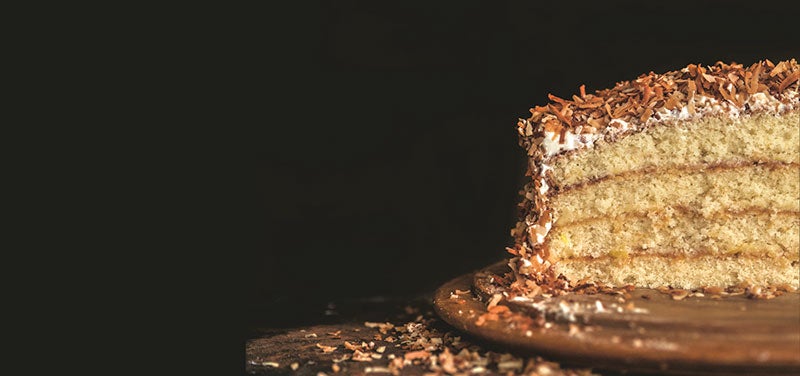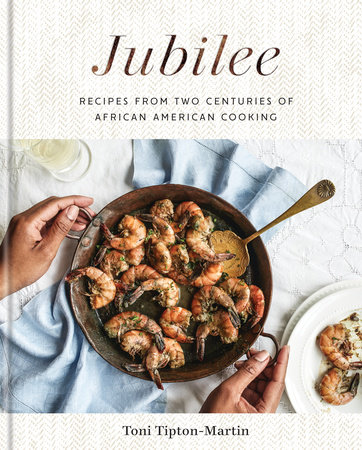Coconut-Lemon Layer Cake from “Jubilee”
Recipes from Two Centuries of African American Cooking: A Cookbook
by Toni Tipton-Martin

Serves 10 to 12
Think about the modern-day cakewalk, and the image that comes to mind is of giddy children, prancing around in a circle to festive music, hoping fortune will smile on them and award them a cake when the music stops. But in the pre–Civil War South, the “cakewalk” was an exaggerated dance the enslaved performed near their cabins or in the woods to mock the ballroom pretension displayed by the plantation aristocracy. At the end of an evening of strutting, twirling canes, and tipping top hats, a prize was presented to the winning couple, “a towering, extra sweet coconut cake,” Eliza Diggs Johnson, who was born on a Missouri plantation, recalled.
Although the dance was a parody of whites, it began crossing into popular culture in the 1870s through the minstrel stage, dance con- tests (such as the national “Cakewalk Jubilee” at New York’s Madison Square Garden), musical plays, sheet music, and films; it entered American vocabulary through the expressions “takes the cake” and “that was a cakewalk.” Charles Johnson, the “Cakewalk King,” and his wife, Dora Dean, reclaimed the African American origins of the dance in an elegant performance on Broadway. Johnson’s appreciation for the cakewalk sprang from the stories told by his mother, the aforementioned Eliza Diggs Johnson, according to an essay in Africanisms in American Culture.
Like so many things associated with plantation social life, coconut cake eventually became a centerpiece of African American special occasions, reserved for weddings, funerals, church suppers, and Christmastime.
For its base, cooks followed one of several butter cake formulas, each adapted well to all sorts of flavorings, toppings, and frostings, limited only by the baker’s imagination. Some chose the simple 1-2-3-4 cake formula, which refers to the amounts of butter, sugar, our, and eggs in the recipe; others preferred gold cake, in which the batter is enriched with egg yolks only; almond, coconut, or vanilla extract determined the cake’s character; and the layers might be topped with a pineapple, lemon, or lime filling; but always, it was fresh coconut pressed into u y white mountain frosting that made the cake truly special.
The confectioners of old stirred the filling in a bain-marie, “a kettle set in a kettle of hot water,” until it thickened. Next generations called that a double boiler. I updated the process by cooking the mixture in a saucepan. You will need to keep the heat low and your eyes on the pot to prevent the eggs from heating too quickly and curdling. Or, skip the fruit fillings. Spread the warm cake with your favorite jelly, or poke holes all over the cake and then brush the layers with fruit juice, as Dora Charles suggests in A Real Southern Cook in Her Savannah Kitchen, a book that sheds light on the complicated relationship between a black cook and her white employer and the recipes they develop together. Toasted coconut on the frosted cake makes a gorgeous garnish. I use less than suggested by bakers of previous generations, but let your taste buds decide how much coconut and whether you like toasted, untoasted (which is chewy and sweet), or a little of both. To surprise your family and friends with a bit of Creole lagniappe (which means “something extra”), stir some sweetened coconut into the filling.
INGREDIENTS
Cooking spray or shortening, for the pan
21⁄2 cups all-purpose our, plus more for the pan
2 teaspoons baking powder
1⁄2 teaspoon salt
1 cup whole milk
1 teaspoon vanilla extract
2 sticks (8 ounces) butter, at room temperature
13⁄4 cups sugar
4 large eggs
Lemon Filling (recipe follows)
Buttercream Frosting (recipe follows)
1 cup sweetened shredded coconut, or more if desired
STEPS
- Preheat the oven to 350°F. Lightly coat two 9-inch cake pans with cooking spray or shortening. Cut rounds of parchment paper to line the bottoms of the pans. Coat again with spray or shortening. Dust lightly with our, shaking out the excess.
- In a medium bowl, whisk together the flour, baking powder, and salt. In a small bowl or measuring cup, combine the milk and vanilla.
- In a stand mixer fitted with the paddle attachment, cream the butter on medium speed until light, 2 to 3 minutes. Gradually beat in the sugar until light and u y, about 3 minutes more. Scrape down the sides of the bowl. Add the eggs, one at a time, beating well after each addition until the eggs are completely incorporated. Beat in the flour mixture in three additions, alternating with the milk mixture, and beginning and ending with the flour. Beat just until the batter is smooth.
- Pour the batter into the pans and bake until a wooden pick inserted in the center comes out clean, 30 to 35 minutes. Cool the cakes in the pans on a wire rack for 10 minutes, then turn out onto the wire rack to cool completely.
- When the cakes are cool enough to handle, use a serrated knife to slice each layer horizontally in half to make 4 total layers. Place one layer, cut side down, on a serving plate. Spread with one-third of the lemon filling. Repeat with 2 more cake layers and filling. Top with the last cake layer. Refrigerate for 30 minutes to allow the cake to set.
- Use a cake spreader or thin spatula to spread one-third of the buttercream frosting over the top and sides of the cake to coat the crumb. Spread the cake with the remaining frosting. Sprinkle the top and sides of the cake with the coconut, pressing gently. Refrigerate until ready to serve.
LEMON FILLING
Makes 2 to 2½ cups
INGREDIENTS
3 large egg yolks, beaten
3⁄4 cup sugar
2 tablespoons cornstarch
1 tablespoon grated lemon zest
1⁄2 cup fresh lemon juice (from 2 to 3 lemons)
6 tablespoons butter, at room temperature, cut into 4 pieces
1⁄2 cup sweetened shredded coconut (optional)
STEPS
- Place the egg yolks in a heatproof bowl.
- In a medium saucepan, combine the sugar and cornstarch. Whisk in 1⁄2 cup water, the lemon zest, and lemon juice. Bring to a boil over medium heat, stirring constantly, then reduce the heat to low and cook until the mixture has thickened. Whisk one-third of the hot mixture into the egg yolks to temper them. Return the warmed egg yolk mixture to the pan. Cook and stir over medium heat until the mixture thickens and resembles pudding, about 10 minutes.
- Remove the filling from the heat. Whisk in the butter, one piece at a time. Stir in the coconut, if desired. Place the filling in a small bowl. Cover with wax paper and chill until needed.
BUTTERCREAM FROSTING
Makes about 4 cups
INGREDIENTS
2⁄3 cup butter, at room temperature
5 cups powdered sugar
1 teaspoon vanilla extract
1⁄2 cup whole milk, as needed
STEPS
In a stand mixer fitted with the paddle attachment, beat the butter at medium speed until light and fluffy, about 3 minutes. Scrape down the sides of the bowl. Gradually beat in the powdered sugar, beating until well blended. Beat in the vanilla and enough milk to make a smooth frosting. Beat until light and fluffy, about 2 minutes longer.
ABOUT THE BOOK
Jubilee
Recipes from Two Centuries of African American Cooking: A Cookbook
Toni Tipton-Martin
JAMES BEARD AWARD WINNER • IACP AWARD WINNER • IACP BOOK OF THE YEAR • TONI TIPTON-MARTIN NAMED THE 2021 JULIA CHILD AWARD RECIPIENT
NAMED ONE OF THE BEST COOKBOOKS OF THE YEAR BY The New York Times Book Review • The New Yorker • NPR • Chicago Tribune • The Atlantic • BuzzFeed • Food52
Throughout her career, Toni Tipton-Martin has shed new light on the history, breadth, and depth of African American cuisine. She’s introduced us to black cooks, some long forgotten, who established much of what’s considered to be our national cuisine. After all, if Thomas Jefferson introduced French haute cuisine to this country, who do you think actually cooked it?
In Jubilee, Tipton-Martin brings these masters into our kitchens. Through recipes and stories, we cook along with these pioneering figures, from enslaved chefs to middle- and upper-class writers and entrepreneurs. With more than 100 recipes, from classics such as Sweet Potato Biscuits, Seafood Gumbo, Buttermilk Fried Chicken, and Pecan Pie with Bourbon to lesser-known but even more decadent dishes like Bourbon & Apple Hot Toddies, Spoon Bread, and Baked Ham Glazed with Champagne, Jubilee presents techniques, ingredients, and dishes that show the roots of African American cooking—deeply beautiful, culturally diverse, fit for celebration.
Praise for Jubilee
“There are precious few feelings as nice as one that comes from falling in love with a cookbook. . . . New techniques, new flavors, new narratives—everything so thrilling you want to make the recipes over and over again . . . this has been my experience with Toni Tipton-Martin’s Jubilee.”—Sam Sifton, The New York Times
“Despite their deep roots, the recipes—even the oldest ones—feel fresh and modern, a testament to the essentiality of African-American gastronomy to all of American cuisine.”—The New Yorker
“Jubilee is part-essential history lesson, part-brilliantly researched culinary artifact, and wholly functional, not to mention deeply delicious.”—Kitchn
“Tipton-Martin has given us the gift of a clear view of the generosity of the black hands that have flavored and shaped American cuisine for over two centuries.”—Taste



